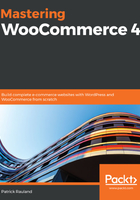
Importance of test sites
If you've been a WordPress developer for a while, you're probably familiar with test sites. And while they're important in regular WordPress development, they're critical in WooCommerce development. The following screenshot shows what a website development process looks like:

With a typical WordPress development project, you'll build custom functionality on your local machine. Then, you'll upload it to a test site where the client usually approves it. Then, you move the test site to the live site, replacing data and files.
And this works great for most WordPress projects. But when it comes to e-commerce, there are two problems:
- You can never replace the live database: Since an e-commerce site is always on and always accepting new orders, payments, and marking items as shipped, you can't replace the live database with the test database.
- E-commerce functionality often needs a publicly accessible URL to work properly: A lot of e-commerce functionality (shipping, payment, and taxes) interacts with third parties, some of which need a publicly accessible URL to return data. So, it's much harder to test your site on a local machine.
Since the e-commerce site has more demands, we're going to cover some of the things you need to do with a test site:
- Migrate files but not the database
- Test with a publicly accessible URL
With these two extra criteria met, both of which can be done by a good website host, you can easily test and launch your own WooCommerce site. Let's look into migrating files first.